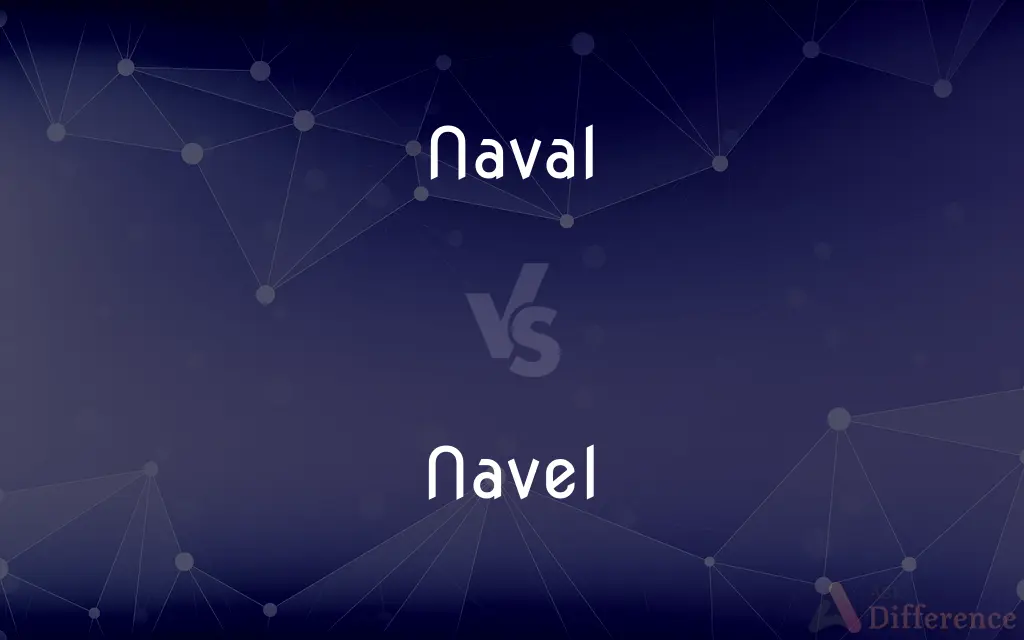Naval vs. Navel — What's the Difference?
Edited by Tayyaba Rehman — By Maham Liaqat — Updated on April 26, 2024
Naval relates to a nation's navy or warships, focusing on maritime military aspects, whereas navel refers to the belly button, a mark on the abdomen where the umbilical cord was attached.

Difference Between Naval and Navel
Table of Contents
ADVERTISEMENT
Key Differences
Naval operations pertain to activities involving a country's navy, including the use of warships and submarines, while navel has no military connotations and simply denotes the central part of the human abdomen where the umbilical cord was once attached.
In historical contexts, naval power has often determined a nation's strength and influence over seas, whereas the navel is primarily of significance in medical and cultural contexts.
Technological advancements in naval capabilities can significantly impact global maritime security, whereas developments concerning the navel are usually limited to medical procedures like laparoscopic surgery.
The design and strategy behind naval ships are crucial for national defense and maritime logistics, while the appearance and location of the navel can vary slightly among individuals but does not serve a functional purpose after birth.
Naval history is rich with stories of battles and exploration that have shaped world history, on the other hand, the navel is often featured in various cultural beliefs and practices, such as those involving body aesthetics.
ADVERTISEMENT
Comparison Chart
Definition
Pertaining to navy or warships
The belly button or umbilicus
Relevance
Military and strategic
Medical and cultural
Technological Impact
High (warfare, logistics)
Low (medical procedures)
Historical Impact
Significant in world history
Minor, mostly cultural
Functional Purpose
Defense, power projection
No functional purpose post-birth
Compare with Definitions
Naval
Involving navy tactics and strategies.
The naval battle demonstrated superior strategic planning.
Navel
Culturally significant in many societies.
In some cultures, the navel is considered a beauty symbol.
Naval
Concerned with building and maintaining warships.
The naval engineer designed a new class of destroyer.
Navel
Medically known as the umbilicus.
Navel infections are common in newborns.
Naval
Pertaining to ships or war-related maritime activities.
The naval fleet was deployed to protect international waters.
Navel
Often a focal point in body art or cosmetic surgery.
She got a navel piercing for her birthday.
Naval
Relating to the service, personnel, or affairs of a navy.
Naval officers undergo rigorous training at the academy.
Navel
Sometimes referred to colloquially as the belly button.
He cleaned lint from his navel.
Naval
Associated with the governmental body overseeing a nation's navy.
The naval budget has been increased this year.
Navel
The scar on the abdomen where the umbilical cord was attached in the womb.
His shirt rode up, exposing his navel.
Naval
Of or relating to a navy.
Navel
The navel (clinically known as the umbilicus, commonly known as the belly button) is a protruding, flat, or hollowed area on the abdomen at the attachment site of the umbilical cord. All placental mammals have a navel.
Naval
Having a navy
A great naval power.
Navel
The mark on the surface of the abdomen of mammals where the umbilical cord was attached during gestation. Also called umbilicus.
Naval
(Obsolete) Of or relating to ships or shipping.
Navel
A central point; a middle.
Naval
(nautical) Of or relating to a navy.
Navel
(anatomy) The indentation or bump remaining in the abdomen of mammals where the umbilical cord was attached before birth.
Naval
(nautical) Of or relating to ships in general.
Naval architect
Navel
The central part or point of anything; the middle.
Naval
Having to do with shipping; of or pertaining to ships or a navy; consisting of ships; as, naval forces, successes, stores, etc.
Navel
A navel orange.
Naval
Connected with or belonging to or used in a navy;
Naval history
Naval commander
Naval vessels
Navel
(historical) An eye on the underside of a carronade for securing it to a carriage.
Navel
A mark or depression in the middle of the abdomen; the umbilicus; called also belly button in humans. See Umbilicus.
Navel
The central part or point of anything; the middle.
Within the navel of this hideous wood,Immured in cypress shades, a sorcerer dwells.
Navel
An eye on the under side of a carronade for securing it to a carriage.
Navel
Scar where the umbilical cord was attached
Navel
The center point or middle of something
Common Curiosities
Is it safe to pierce the navel?
Yes, it is generally safe to pierce the navel, but proper hygiene and care are crucial to prevent infections.
Can naval strategies affect global politics?
Yes, naval strategies can significantly influence global politics by controlling sea routes and asserting maritime dominance.
How is the navel formed?
The navel is formed where the umbilical cord was attached and cut after birth, leaving a scar.
Why do navels differ in shape?
Navels differ in shape due to individual differences in how the umbilical cord scar heals.
Are there any health concerns associated with navels?
While generally not a concern, navels can occasionally develop infections, especially in improperly cared for piercings.
What does naval warfare involve?
Naval warfare involves the deployment of ships, submarines, and sometimes aircraft to gain advantage over adversaries at sea.
What is the primary function of naval forces?
Naval forces primarily ensure maritime security, engage in warfare, and support international peacekeeping efforts.
What is the role of a naval officer?
A naval officer commands ships, manages crew, and participates in strategic planning and operations.
How does naval history impact modern warfare?
Naval history provides insights into tactical evolution and technological advancements that shape modern maritime strategies.
How do cultural perceptions of the navel vary?
Cultural perceptions of the navel vary widely, from being considered an erotic symbol to a taboo body part, depending on societal norms.
Share Your Discovery

Previous Comparison
Wide vs. Narrow
Next Comparison
Electrical vs. ElectronicsAuthor Spotlight
Written by
Maham LiaqatEdited by
Tayyaba RehmanTayyaba Rehman is a distinguished writer, currently serving as a primary contributor to askdifference.com. As a researcher in semantics and etymology, Tayyaba's passion for the complexity of languages and their distinctions has found a perfect home on the platform. Tayyaba delves into the intricacies of language, distinguishing between commonly confused words and phrases, thereby providing clarity for readers worldwide.














































